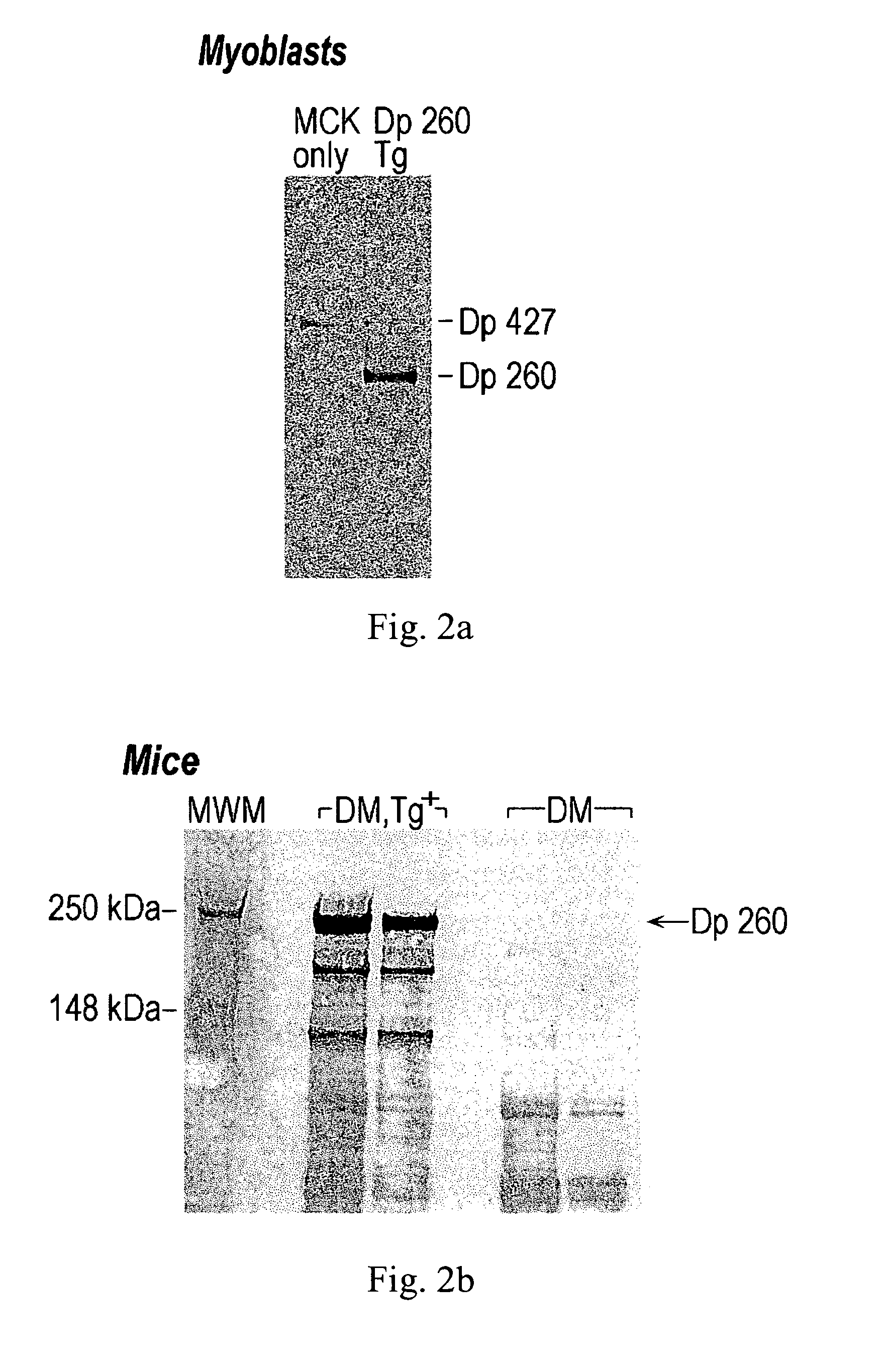Retinal dystrophin transgene and methods of use thereof
- Summary
- Abstract
- Description
- Claims
- Application Information
AI Technical Summary
Benefits of technology
Problems solved by technology
Method used
Image
Examples
example 1
Preparation and Analysis of Human Dp260 Transgene Construct
[0054] The mouse muscle creatine kinase (MCK) promoter and enhancer (SEQ ID NO: 1), along with MCK exon 1 (SEQ ID NO: 2), intron 1 (SEQ ID NO: 3), and a portion of exon 2 (SEQ ID NO: 4) comprising the 5′ untranslated portion of exon 2, were used to produce the final transgene. The regulatory elements of MCK with its first exon and part of its first intron (SEQ ID NO: 5) were cloned directly into a pBluescript II SK vector (Stratagene, La Jolla, Calif.). The first PCR amplicon, consisting of the remainder of MCK intron 1 and exon 2, up to the MCK ATG start codon (SEQ ID NO: 6), was amplified by PCR to generate an NdeI restriction site. This allowed ligation to the NdeI restriction site of a human genomic PCR amplicon. The second PCR amplicon started with the ATG start codon of the retinal dystrophin unique first exon R1, continued with intron R1, and ended in exon 30 (SEQ ID NO: 7), which was placed at the exact position whe...
example 2
Production of DM Human Dp260 Transgenic Mice
[0057] The human Dp260 transgene construct was extracted with the Endo Free Plasmid Kit (Quiagen, Valencia, Calif.) and was released from the plasmid vector by restriction digest with NotI prior to oocyte injection. The construct was injected into 200 eggs, which were then transplanted into psuedopregnant females, delivered, and weaned. Genotyping for the Dp260 transgene identified two mice that had incorporated the human Dp260 transgene. Genotyping was performed by PCR reactions using an MCK-specific forward primer (SEQ ID NO: 14) and a dystrophin human exon 30-specific reverse primer (SEQ ID NO: 15) which amplified a transgene-specific product of less than 400 bp (SEQ ID NO: 16). Both lines of mice showed strong expression of the transgene and may differ by the location of insertion into the genome, and the number of copies of the transgene inserted into the mouse's genome. The transgenic mice thusly identified as having the TgN(DMD 260...
example 3
Western Blotting
[0060] Differentiated MM14 myoblast cell cultures, stably transfected with either the human MCK / Dp260 Tg or the MCK plasmid alone, were harvested. Protein was extracted from 3 million cells by homogenizing in 1 mL of homogenization buffer (50 mM Tris pH 8, 150 mM NaCl, 1 mM EDTA, 0.04 mg / mL aprotinin, 0.0025 mg / mL pepstatin A, 0.025 leupeptin, 1 mM phenylmethyl sulfonylfluoride, 0.1% Triton X100) in a Dounce homogenizer. Muscle tissue was also harvested (100 mg) from the hind legs of DM / Tg+, and DM mice. The tissue was frozen and was homogenized in 1 mL homogenization buffer using a chilled mortar and pestle. The homogenates were centrifuged for 10 minutes at 13,000 rpm at 4° C. to sediment cell debris.
[0061] A 4× loading buffer (Invitrogen) was added to the supernatant, and the proteins were heat denatured at 70° C. for 10 minutes. Aliquots of 24 μL were analyzed on 4-8% acrylamide gels using a NuPAGE Tris-Acetate SDS Gel System (Invitrogen). Proteins were transfe...
PUM
| Property | Measurement | Unit |
|---|---|---|
| Fraction | aaaaa | aaaaa |
| Time | aaaaa | aaaaa |
| Weight | aaaaa | aaaaa |
Abstract
Description
Claims
Application Information
 Login to View More
Login to View More - R&D
- Intellectual Property
- Life Sciences
- Materials
- Tech Scout
- Unparalleled Data Quality
- Higher Quality Content
- 60% Fewer Hallucinations
Browse by: Latest US Patents, China's latest patents, Technical Efficacy Thesaurus, Application Domain, Technology Topic, Popular Technical Reports.
© 2025 PatSnap. All rights reserved.Legal|Privacy policy|Modern Slavery Act Transparency Statement|Sitemap|About US| Contact US: help@patsnap.com



